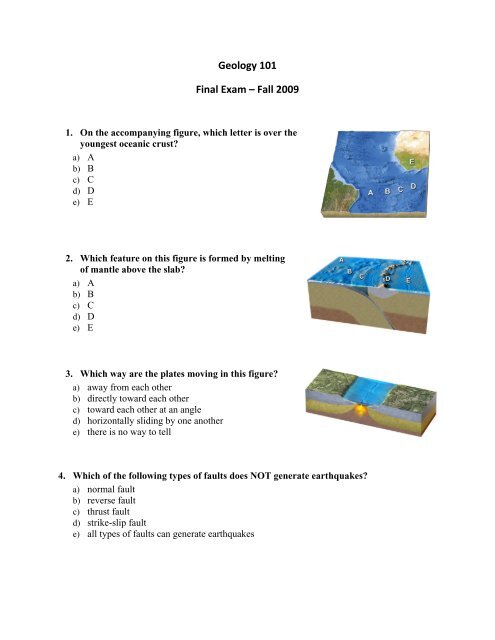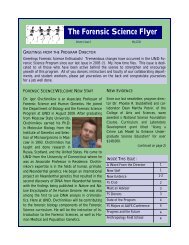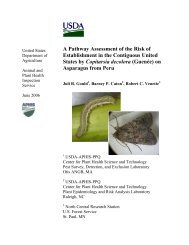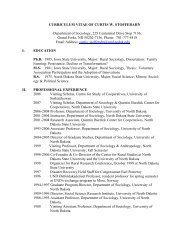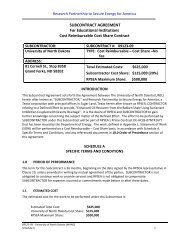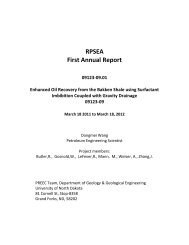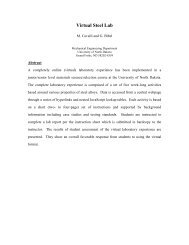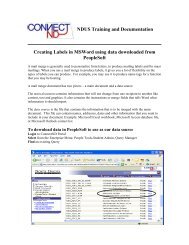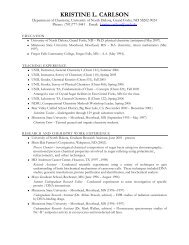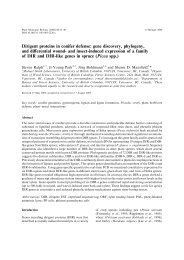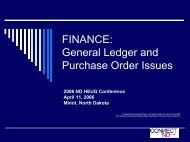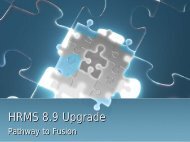Create successful ePaper yourself
Turn your PDF publications into a flip-book with our unique Google optimized e-Paper software.
<strong>Geology</strong> <strong>101</strong><br />
<strong>Final</strong> <strong>Exam</strong> – <strong>Fall</strong> <strong>2009</strong><br />
1. On the accompanying figure, which letter is over the<br />
youngest oceanic crust?<br />
a) A<br />
b) B<br />
c) C<br />
d) D<br />
e) E<br />
2. Which feature on this figure is formed by melting<br />
of mantle above the slab?<br />
a) A<br />
b) B<br />
c) C<br />
d) D<br />
e) E<br />
3. Which way are the plates moving in this figure?<br />
a) away from each other<br />
b) directly toward each other<br />
c) toward each other at an angle<br />
d) horizontally sliding by one another<br />
e) there is no way to tell<br />
4. Which of the following types of faults does NOT generate earthquakes?<br />
a) normal fault<br />
b) reverse fault<br />
c) thrust fault<br />
d) strike-slip fault<br />
e) all types of faults can generate earthquakes
5. A convergent plate boundary is most likely associated with a(n):<br />
a) oceanic trench<br />
b) mountain belt or island arc<br />
c) mid-ocean ridge<br />
d) a and b only<br />
e) none of these<br />
6. Which of the following is a mineral?<br />
a) ice<br />
b) crystals grown in a laboratory<br />
c) volcanic glass<br />
d) material with crystals of different chemical compounds<br />
e) none of these<br />
7. Which of the following is true about rocks and minerals?<br />
a) a rock can contain more than one mineral<br />
b) a mineral is composed of chemical elements<br />
c) a rock can be made of only one mineral<br />
d) a rock may not contain any minerals<br />
e) all of the above<br />
8. The most important class of rock-forming minerals on Earth is:<br />
a) halides<br />
b) sulfates<br />
c) native minerals<br />
d) silicates<br />
e) asbestos<br />
9. This diagram indicates that:<br />
a) S-waves are the first wave to arrive at station<br />
and then die out into P-waves<br />
b) S-waves are the last wave to arrive at the<br />
station<br />
c) P-waves arrive first, followed by S-waves<br />
d) surface waves arrive first, followed by S-<br />
waves and then P-waves<br />
e) surface waves cause the smallest vibrations
10. The three elements most abundant in the Earth’s crust are:<br />
a) sulfur, oxygen, helium<br />
b) helium, hydrogen, oxygen<br />
c) aluminum, potassium, sodium<br />
d) oxygen, silicon, aluminum<br />
e) hydrogen, helium, and argon<br />
11. The site on the accompanying figure that would most likely form<br />
a rock with large crystals is:<br />
a) A<br />
b) B<br />
c) C<br />
d) D<br />
e) E<br />
12. A finely crystalline or glassy igneous texture indicates that:<br />
a) there was a lot of gas in the magma<br />
b) the rock cooled quickly<br />
c) the rock broke apart as it flowed<br />
d) the rock cooled slowly<br />
e) the ash and pumice were hot and became compacted<br />
13. Which letter in this classification table<br />
indicates the position of basalt?<br />
a) A<br />
b) B<br />
c) C<br />
d) D<br />
e) E<br />
14. When melting forms magma:<br />
a) rocks in the source region generally are completely melted<br />
b) partial melting may produce a magma that is more felsic than the source<br />
c) melting of the mantle generally produces felsic magma<br />
d) melting of continental crust generally produces mafic magma<br />
e) none of these
15. What type of volcanic eruption is shown in this photograph?<br />
a) a lava fountain<br />
b) collapse of a volcanic dome<br />
c) a fissure eruption<br />
d) a pyroclastic column<br />
e) a volcanic mudflow<br />
16. In which of the following environments is the lithosphere likely to be thinnest?<br />
a) beneath a major mountain range<br />
b) beneath a mid-ocean ridge<br />
c) beneath a typical part of the abyssal plain<br />
d) a tectonically active continental margin<br />
e) the interior of a continent away from plate boundaries<br />
17. The diagram on the right shows the record of one<br />
earthquake on seismograms at three different<br />
stations in a seismic network. These three<br />
seismograms show:<br />
a) ISCO station is closest to the earthquake<br />
b) WUAZ station was right at the earthquake<br />
c) DUG station is farthest from the earthquake<br />
d) WUAZ is the closest station, followed by DUG, and<br />
then ISCO<br />
e) none of these<br />
18. Which of the following volcanoes is generally the largest?<br />
a) scoria cone<br />
b) dome<br />
c) sulfur volcano<br />
d) composite volcano<br />
e) shield volcano
19. Which of the following is true about tar-sand oil?<br />
a) mining tar sand is done underground and so does not scar the surface<br />
b) tar sand oil is not being mined anywhere today but may be in the future<br />
c) tar sand oil does not need any refining<br />
d) almost all the tar sand oil has been used up<br />
e) tar sand oil is being produced at significant rates in Canada today<br />
20. What types of rocks would be most common in the<br />
volcano (Mauna Kea, Hawaii) shown in this photograph?<br />
a) scoria<br />
b) basalt mostly formed in lava flows<br />
c) felsic and intermediate lava flows<br />
d) tuff and tephra<br />
e) none of these<br />
21. How did the Ural Mountains within the middle of the Eurasian plate form?<br />
a) uplift of the Asian Plateau, followed by erosion of limestones and other highly soluble<br />
rocks<br />
b) stresses from a distant plate boundary reactivated ancient faults<br />
c) the continent is beginning to break apart along a line of hot spots<br />
d) the area is presently a plate boundary<br />
e) two continents collided, trapping the mountain within the new, larger continent<br />
22. Typically, how many seismometers record the tremors produced by a moderate<br />
strength earthquake?<br />
a) Typically 3 or 4, but maybe not any<br />
b) It depends on whether there are any seismic stations nearby<br />
c) None if the seismic waves travel through the core<br />
d) Many hundreds<br />
e) 400 million billion finity<br />
23. Which of the following is NOT a typical match between the type of eruption and<br />
resulting rock type?<br />
a) lava from a composite volcano – andesite<br />
b) rapidly cooling felsic magma – obsidian<br />
c) eruption column – tephra<br />
d) pyroclastic flow – scoria<br />
e) volcanic-derived mudflow – breccia with angular fragments
24. Which of the following environments would most<br />
likely consist of sand and/or rounded cobbles?<br />
a) beach at A<br />
b) lagoon at B<br />
c) coral reef at C<br />
d) deep seafloor at D<br />
e) tidal flat at E<br />
25. What is the best explanation for the shape of these clasts?<br />
a) they are composed of relatively soft, soluble materials<br />
b) they accumulated on a steep slope<br />
c) they have been moved by the wind and rounded by blowing<br />
sand in sand dunes<br />
d) they have been transported a significant distance<br />
26. What is the origin of smooth troughs cutting across the landscape in the Great Lakes<br />
area?<br />
a) the areas were covered by soft marine sediments<br />
b) faulting and folding<br />
c) a huge flood coming from Iowa flowed toward the Great Lakes<br />
d) glaciers carved the smooth troughs<br />
e) floods during the Precambrian<br />
27. What is true about world petroleum supplies?<br />
a) Supplies are dwindling<br />
b) Production is falling or can be expected to fall in the near future<br />
c) Most of the large, easy to produce, oil has already been found<br />
d) We rely on petroleum to maintain our life styles<br />
e) all of these
28. What type of rock is shown in this photograph?<br />
a) conglomerate<br />
b) breccia<br />
c) sandstone<br />
d) siltstone or shale<br />
e) tuff<br />
29. What type of rock would you expect to form in this environment,<br />
showing a dried up lake bed?<br />
a) rock salt and other evaporite minerals<br />
b) limestone<br />
c) coal<br />
d) chert<br />
e) iron formation<br />
30. The large sloping beds in these rocks are:<br />
a) braided beds<br />
b) graded beds<br />
c) flower beds<br />
d) cross beds<br />
e) imbricate beds<br />
31. This sandstone includes small rounded pebbles and was<br />
deposited far from the ocean. What is the most likely<br />
environment in which it formed?<br />
a) sand dunes<br />
b) river<br />
c) beach next to a sea<br />
d) shallow lake<br />
e) deep-water turbidity currents<br />
32. If a landscape has karst topography, it is most likely underlain by:<br />
a) granite or diorite, etc.<br />
b) conglomerate<br />
c) shale<br />
d) siltstone<br />
e) limestone
33. Which of the following is characteristic of a transgression?<br />
a) the seas move out, uncovering more land<br />
b) sand dunes and river sediments can be deposited over marine deposits<br />
c) marine sedimentary facies move toward the land<br />
d) marine sedimentary facies move away from land<br />
e) all of the above<br />
34. What is one reason why the East Coast has so many bays and islands?<br />
a) the land has been uplifted by recent faulting<br />
b) because of a major drop in sea level<br />
c) the land has been downdropped by recent faulting<br />
d) water released from melting glaciers raised sea level<br />
e) a large tsunami from a meteoroid impact scoured the coastline<br />
35. Which of the following is most likely to occur at shallow crustal levels?<br />
a) ductile behavior<br />
b) brittle deformation<br />
c) growth of new minerals<br />
d) recrystallization of minerals<br />
e) metamorphism<br />
36. What happens during the maturation of coal?<br />
a) impurities are driven off<br />
b) the coal is buried and squeezed to a smaller volume<br />
c) the energy content of the coal increases<br />
d) methane is driven off<br />
e) all of these<br />
37. What type of stress formed the structure shown in this figure?<br />
a) uniaxial<br />
b) fluid pressure<br />
c) compression<br />
d) confining pressure<br />
e) tension
38. What type of fault is shown in this figure?<br />
a) dip-slip fault<br />
b) normal fault<br />
c) strike-slip fault<br />
d) reverse fault<br />
e) right-lateral fault<br />
39. What type of structure is shown in this figure?<br />
a) thrust fault<br />
b) anticline<br />
c) syncline<br />
d) monocline<br />
e) basin<br />
40. Which of the following most likely indicates that sea level has fallen relative to the<br />
land?<br />
a) offshore sand bars that have become coastal dunes<br />
b) the presence of coral reefs on land<br />
c) wave-cut notches and platforms that are above sea level<br />
d) marine terraces<br />
e) all of these<br />
41. Oil and gas form from:<br />
a) accumulation of inorganic material, such as clay particles in shale<br />
b) oxidation of organic material at the surface<br />
c) gummy bears<br />
d) heating of rocks to metamorphic temperatures (at least 400°C)<br />
e) heating and breakdown of long hydrocarbon chains into smaller molecules<br />
42. Which of the sites on this cross section would<br />
be the most likely place for a spring?<br />
a) A<br />
b) B<br />
c) C<br />
d) D<br />
e) All are equally likely
43. What type of metamorphic feature is shown in this<br />
photograph?<br />
a) cleavage in slate<br />
b) schistosity<br />
c) hornfels<br />
d) foliation in banded gneiss<br />
e) thrust fault<br />
44. Which of the following matches a sedimentary rock with a possible metamorphic<br />
equivalent?<br />
a) sandstone – greenstone<br />
b) basalt – marble<br />
c) limestone – quartzite<br />
d) shale – slate<br />
e) diatomite – diamond<br />
45. What is true about contact metamorphism?<br />
a) It always involves a magma<br />
b) It generally takes place in the crust<br />
c) It frequently produces unfoliated rocks<br />
d) It may occur at very high temperatures<br />
e) All of the above are correct<br />
46. In what environments does high pressure/low temperature metamorphism occur?<br />
a) near magma but at shallow levels<br />
b) near magma but at deep levels<br />
c) under normal conditions of burial and heating<br />
d) in a subduction zone or accretionary prism<br />
e) none of these<br />
47. What happens when a glacier retreats?<br />
a) ice near the toe of the glacier actually moves uphill<br />
b) melting occurs only above the line and sublimation occurs only below the line<br />
c) ice melts faster than it is replaced by downhill flow<br />
d) crevasses form above the equilibrium line; they fill below the equilibrium line<br />
e) icebergs form and sea level drops
48. What type of feature is shown in this photograph of Siccar<br />
Point, Scotland?<br />
a) monocline<br />
b) thrust fault<br />
c) normal fault<br />
d) unconformity<br />
e) facies change<br />
49. This figure shows the main subdivisions of the geologic<br />
timescale. Which of these is the Paleozoic?<br />
a) A<br />
b) B<br />
c) C<br />
d) D<br />
50. In which of the following time periods did coral, clams, fish, plants and insects become<br />
abundant?<br />
a) Rarazoic<br />
b) Cenozoic<br />
c) Mesozoic<br />
d) Paleozoic<br />
e) Precambrian<br />
51. Which of the following is NOT true about the water table?<br />
a) the water table is right at the land surface in swamps<br />
b) the water table is generally horizontal<br />
c) the water table is above the land surface in lakes<br />
d) it is at a higher level in regions of salt water<br />
e) overpumping can change the slope of the water table
52. What does a terminal moraine represent?<br />
a) the end of a polished and scratched segment of bedrock<br />
b) the sharp ends of a jagged ridge formed by glaciers<br />
c) the end of an ice sheet that is floating in the sea<br />
d) a pile of sediment deposited at the end of the glacier<br />
e) the final time that two glaciers come together<br />
53. The size of clasts that a river can carry is primarily controlled by:<br />
a) the water temperature<br />
b) the dissolved and suspended load of a river<br />
c) how close the river is to the ocean<br />
d) the velocity and turbulence of the current<br />
e) whether it is a permanent or ephemeral stream<br />
54. Which of the following is NOT accurately dated at between 4 and 4.6 billion years old?<br />
a) the oldest dates on mineral grains on Earth<br />
b) age of the oldest meteorites<br />
c) the age of some granites and gneisses<br />
d) age of moon rocks returned to Earth and dated<br />
e) isotopic ages on Earth’s oldest known fossil shell<br />
55. Which of these numbers is near a site with<br />
active seafloor spreading?<br />
a) 1<br />
b) 2<br />
c) 3<br />
d) 4<br />
e) none of these<br />
56. What setting has the thinnest cover of sediment in the oceans?<br />
a) mid-ocean ridges<br />
b) abyssal plain<br />
c) oceanic trenches<br />
d) diapiric deeps<br />
e) continental shelves and slopes along passive margins
57. Which of the following is a condition favoring deposition of sediment?<br />
a) an increase in water velocity<br />
b) a decrease in gradient of the stream<br />
c) an increase in turbulence of the water<br />
d) an increase in the salt content of the water<br />
e) a decrease in grain size as a clast breaks into two pieces<br />
58. Most groundwater pumped in the United States is used for:<br />
a) Industry<br />
b) Barge naivgation<br />
c) irrigation<br />
d) drinking water<br />
e) swimming pools<br />
59. Which of the following is associated with a typical island arc?<br />
a) oceanic trench<br />
b) subduction<br />
c) melting in the mantle<br />
d) ocean-ocean convergence<br />
e) all of these<br />
60. What does a profile of a river from its headwaters to its mouth typically show?<br />
a) an increase in gradient downstream<br />
b) a straight-line profile reflecting a constant decrease in gradient<br />
c) an abrupt increase followed by a gradual decrease<br />
d) a curved shape that flattens out downstream<br />
e) a steeper gradient over time<br />
61. Where is most of Earth’s freshwater?<br />
a) ice caps, glaciers, and groundwater<br />
b) groundwater and rivers<br />
c) lakes and swamps<br />
d) rivers and streams<br />
e) oceans
62. Which of the following sites is the least common place in which oil is trapped?<br />
a) the flanks of a salt dome<br />
b) the upper part of a lens of permeable rock<br />
c) the top of an anticline<br />
d) the bottom of a syncline<br />
63. Which of the following is a characteristic of fine-grained clastic rocks?<br />
a) most clasts are visible with the unaided eye<br />
b) the rocks are poorly sorted<br />
c) the cobbles directly rest on one another without much matrix<br />
d) the rocks tend to be easily eroded<br />
e) the rocks cannot be deposited in a marine environment<br />
64. Which kind of rock makes up the oceanic crust?<br />
a) sandstone<br />
b) limestone<br />
c) mudstone<br />
d) conglomerate or breccia<br />
e) basalt<br />
65. To determine the numerical (absolute) age of a rock, geologists can use<br />
_____________?<br />
a) Principle of superposition<br />
b) The presence of certain index fossils<br />
c) Observations of crosscutting relationships<br />
d) Measurement of radioactive decay products<br />
e) Any of the above can be used


